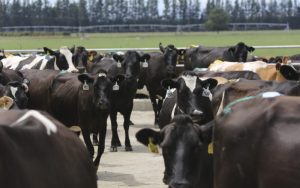
Slight squeeze on global supply helps bolster outlook.
Modest global milk supply has prompted Rabobank to forecast an $8.40 kg/ MS milk price for the 2024-2025 season.
Milk production from the main global export regions will expand only slightly in the third quarter of this year before gaining some momentum towards the end of the year, it predicts.
Rabobank senior agricultural analyst Emma Higgins said low profitability over the past 12 months has led to a decrease in dairy herds in key regions like the United States and South America, while weather-related issues have also affected milk output in recent weeks, with diminished rains in New Zealand and excess rains in Europe.
“This subdued global milk supply growth should help underpin a continuation of the dairy market recovery and an improvement in milk prices for dairy producers in most regions around the world,” Higgins said.
While this is the case, Higgins warned, the recovery will not be smooth.
“Global demand recovery signals are mixed, and consumers’ purchasing power remains under pressure.
“Although unemployment remains close to record low levels in most large markets, consumer sentiment is gloomier than anticipated. Inflation remains above target in most countries and high interest rates continue to put pressure on debts and consumer spending at a time when credit plays an important role after cumulative inflation in recent years.”
Another potential headwind for dairy prices is higher milk production in China.
“We have now revised our milk output in China for 2024 from 2% to 3.2%, reflecting higher-than-anticipated output due to the lagging effect from the last round of dairy expansions during 2019-2022.”
In light of these factors the bank’s view is that the current recovery in dairy market prices will now be slower than anticipated.
“China’s reduced dependence on imports will also be a headwind for the global dairy market in the months ahead.”
The expectation that Chinese milk production will grow at a quicker rate is a particular challenge to Rabobank’s milk price forecast for the upcoming NZ dairy season.
“Chinese production figures are especially significant for New Zealand’s dairy sector given their influence on Chinese import requirements and the fact more than 30% of this country’s dairy exports head to the Chinese market,” she said.
“And we do see this increase in Chinese milk output as a downside risk factor to the New Zealand farmgate milk price.”
While an $8.40kg/MS price would be broadly profitable at a national level, budgetary pressures are likely to remain.
“Should milk prices for the 24/25 season stay near this level, costs will still remain front and centre for the majority of Kiwi dairy farmers.
“Fertiliser applications and quantity alongside labour adjustments are now under review as farmers prepare for another season of tight fiscal control.”
One of the persistent headaches for farmers is the cost of funds and Rabobank expects the Reserve Bank of NZ to cut rates twice this year.
NZ milk production for the current 2023/24 season could end 1% lower due to the impacts of El Niño in northern and eastern areas of both the North and South Island.
Other factors that could impact the market include nitrogen derogation limits in Europe and pathogenic avian flu.
“After earlier announcements about lowering nitrogen derogation limits in the Netherlands and Ireland, Denmark has decided not to apply for a renewal of the nitrogen derogation.
“This means that Denmark will limit the application of organic N from animal manure to 170kg per HA (from 230kg) of grassland, effective July 31 this year. Ultimately, lower application rates reduce the carrying capacity per hectare and potentially increase costs for manure disposal, which could result in farmers re-balancing their herd size,” Higgins said.
Avian bird flu is spreading, infecting cows in eight different US states.
“The disease is primarily symptomatic in older cows, but it is likely younger cows are also infected but asymptomatic. There has not been a measurable reduction in milk supply, but the spreading infection remains a key watch factor from both the supply side and consumer demand lenses,” she said.
You can now read the most important #news on #eDairyNews #Whatsapp channels!!!
🇺🇸 eDairy News INGLÊS: https://whatsapp.com/channel/0029VaKsjzGDTkJyIN6hcP1K

























